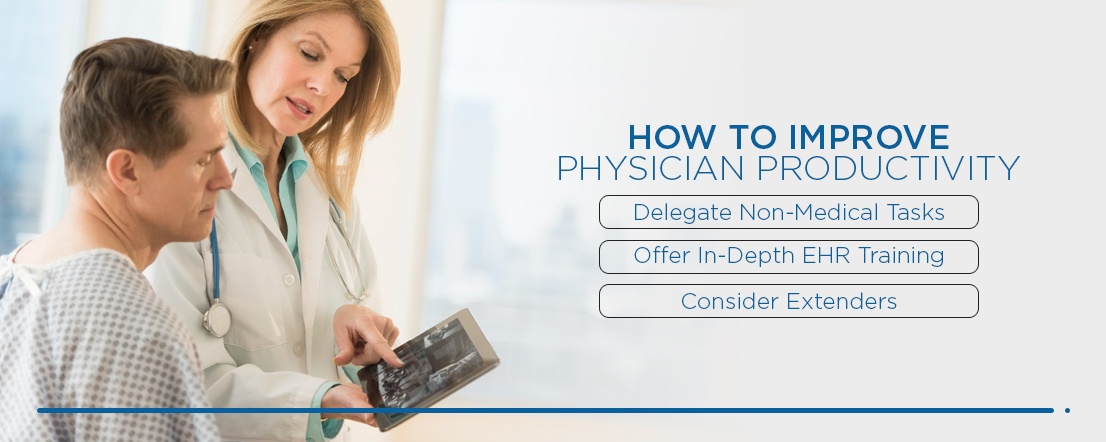Productivity Tools for Doctors
Jul 13, 2020 | Jonathan Maisel
In any medical practice, the scarcest resource is physicians’ time. While it’s possible to add capacity for patient care by hiring more physicians, this option is both expensive and time-consuming. Additionally, it may be impractical or impossible for many smaller practices. A more efficient investment of time and money is providing doctors with the resources they need to improve their productivity. We’ll explore why and how to improve physician productivity with just a few strategic changes.
Why Physician Productivity Is Important
From a management and administration point of view, improved physician productivity translates to more patients and more revenue. Making relatively small adjustments and investing in technologies that ease the burden on physicians is a smart way to ensure a practice remains profitable. Greater productivity can also contribute toward higher scores in the Quality and Cost categories of the Merit-based Incentive Payment System (MIPS), garnering more compensation from the Centers for Medicare & Medicaid Services (CMS).
From a patient care perspective, a productive physician can provide care to more patients without sacrificing quality. Increasing productivity means finding ways to shed unnecessary activities and devote more time to patients, which also reduces the risk of burnout.
How to Measure Productivity in Healthcare
Determining how to improve physician productivity starts with finding a metric to measure productivity. Relative value units (RVU) are a common way to quantify how efficiently a physician works. Each RVU represents a single “unit” of work, considering all the labor and costs that go into care. An RVU consists of three elements:
- Physician labor
- Practice expenses
- Medical liability
It’s important to remember that RVUs are only meaningful in context with one another. Together, they allow you to compare the performance of physicians to external benchmarks. The steps to measure physician productivity with RVUs are:
- Use common procedural technology (CPT) codes to gather data on the number of procedures a doctor has performed in a certain time period.
- Multiply the total RVUs for each CPT code by the number of procedures performed.
- Compare the doctor’s total against benchmarks for other physicians within the specialty.
Doing this can tell you how a physician’s productivity levels measure up to the productivity of peers in the industry. You can obtain RVU values from CMS at no charge. Members of the Medical Group Management Association (MGMA) can obtain benchmarking data from the MGMA website.

How to Improve Physician Productivity
What can you do to bring up physician productivity standards while minimizing the burden on the doctors in your practice? Here are three tips to consider.
1. Delegate Non-Medical Tasks
Electronic health record (EHR) technology was designed to enhance the quality of documentation and allow physicians to provide better care to patients. While the technology continues to advance rapidly, there are still problems with implementation. One of those problems that hampers physician productivity is the sheer number of administrative tasks doctors are expected to complete in relation to each patient visit.
Delegating as many administrative tasks as possible is an ideal way to increase productivity. One eye-opening study indicated that delegating tasks within an EHR resulted in clinicians producing 11% more RVUs per workday — a significant increase for a step that doesn’t cost much, if anything, to implement. Tasks like sending patient test results and providing post-appointment instructions can be handled by other staff, allowing physicians to put their focus elsewhere.
2. Offer In-Depth EHR Training
An analysis of responses from more than 72,000 physicians shows that a lack of EHR training is the number one cause of dissatisfaction among doctors. The study found that the strongest predictor of a negative or positive experience is the quality and extent of training provided, no matter which of seven EHRs the doctors were using.
Another recent study found that new doctors spend two times the hours on EHR use than they do on actual patient care, making it clear a lack of EHR training is a significant barrier to productivity.
If physicians are expected to improve productivity, they need to be able to navigate their EHR effectively. While many doctors are able to make the EHR work for them over time, it is much more efficient to provide thorough training.
3. Consider Extenders
For larger practices considering how to improve productivity, a good solution may be physician extenders like nurse practitioners and physician assistants. These extenders can take care of routine problems and perform checkups for patients with chronic illnesses so doctors can focus on the most pressing cases.
Programs like MIPS are indicators that value-based care is coming into greater focus. That means providing better care to chronically ill patients can boost quality scores, bringing in larger incentive payments. Extenders represent a significant investment, but if you have enough patient demand, they can greatly increase physician productivity and overall revenue.
How to Increase Productivity in Medical Transcription
Doctors are under immense pressure to provide detailed documentation through EHR systems that are not always optimized for efficiency. One of the best ways to improve physician productivity is to take the tedious task of EHR documentation off their plates with medical transcription services.
Medical transcription makes it easy for physicians to create documentation through dictation. Rather than spending time in an appointment typing and clicking away, a physician can speak to the patient face-to-face and verbally take notes in a more natural, narrative pattern. After the recording is complete, the audio file is translated into EHR-friendly text with the appropriate codes. Some platforms like ZyDoc offer transcription with automatic EHR insertion, so once a doctor takes notes, they don’t need to worry about retrieving and filing them afterward.
On an average weekday, physicians spend nearly 6 hours of an 11.4-hour workday on EHR tasks. That includes 1.4 hours of EHR time after work, making documentation the largest time sink for most doctors. Transitioning to a medical transcription service can potentially save physicians hours of documentation each day.
Advance Your Practice With ZyDoc
Improving physician productivity can take significant time and investment. However, choosing medical transcription provides a quick and cost-effective transition that gives physicians more time to build up RVUs in a day.
ZyDoc’s medical transcription services are simple to use and have turnaround times of two hours, all with an accuracy rate of at least 98%. By simplifying physician workflow, medical transcription provides an efficient method of raising physician productivity standards while reducing the pressures of EHR use.
To find out more about what ZyDoc can do for your practice, call 1-800-546-5633 today. You can also browse our transparent plans and pricing to determine which plan is right for you, and request a free 14-day trial of the software.

